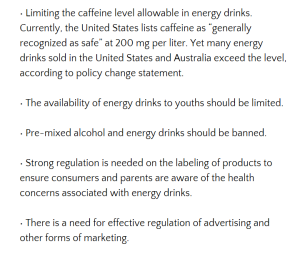Energy drinks are in the news again, but it's not for any new reason. Too much caffeine is not good for anyone, but that you already knew. With the new Dietary Guidelines proposed by the DGAC comes a renewed warning that energy drinks can be dangerous. But is the DGAC focusing on the right message? Yes, and no.
A massive study published in 2014 showed that 85% of the American population consumes at least one caffeinated beverage per day, but only 10% of that group gets their caffeine from energy drinks. In this study, teenagers and young adults are the biggest proportion of energy drink consumers, but still, less than 10% of tweens, teens and young adults get their caffeine from this source (about 70% get their caffeine from carbonated soft drinks). Teens who use energy drinks consume on average 60 mg caffeine per day, which is under the 100mg limit for adolescents proposed by the American Academy of Pediatrics. For age groups 6-12 and 18-24 there weren’t enough energy drink consumers to calculate intake averages, but the total amount of caffeine (from all sources) consumed by those under 18 is still under this 100mg limit. -- read the rest of the recap on this massive study here: "Caffeine Consumption in the USA"
The DGAC got it right when they said...
The committee said moderate coffee consumption may be incorporated into a healthy diet, but high caffeine intake, or greater than 400 mg per day for adults, may occur with the rapid consumption of large-size energy drinks.The DGAC echoes the recommendations of the First International Energy Drinks Conference at Deakin University, Burwood, Victoria, Australia. That committee recommended the following:
The D.G.A.C. recommended limited or no consumption of high caffeine drinks, or other products with high amounts of caffeine, for children and adolescents. The committee said energy drinks should not be consumed with alcohol.
----Excerpted from the Food Business News article, "DGAC puts energy drinks back in the spotlight"
Lingering concerns
I fervently agree with the DGAC committee and the recommendations of the First International Energy Drinks Conference: mixing caffeine (from any source) and alcohol is a bad idea. Caffeine Informer has already summarized all the reasons why this combo is bad (see here). So let's discuss the gray areas instead.
Many conclude that the energy drink situation is a result of regulatory failure, and that more laws and bans are the answer. Some legislators have already tried that, but as I've pointed out in previous posts, this strategy has a low success rate.
The problem lies in the sheer variety of products marketed as an "energy drink". Some of these don't even have caffeine -- vitamin B12 is the most popular energy drink ingredient. (See "Ten Things No One is Telling You About Energy Drinks")
As I commented on the Food Business News article:
While I agree with the Key Policy Changes outlined above, it's important to note that the top-selling energy drink is Red Bull, which features 80mg caffeine per 8oz can. the next top selling, Monster and Rockstar have not more than 240mg per can. YES, the Super-Sized cans are disconcerting, but more energy and focus (pun intended) should be placed on the combination of caffeine and alcohol than on demonizing a particular brand. Furthermore, when popular coffee drinks include more caffeine than popular energy drinks, an energy drink ban for minors seems illogical. Too much caffeine is too much, regardless of whether it comes in a cup, mug or can.
-- GreenEyedGuide
For more Food Science in the News articles: visit this pageDon’t miss any food science or caffeine related posts — follow GreenEyedGuide on Twitter and Like the Energy Drink Guide on Facebook

No comments:
Post a Comment